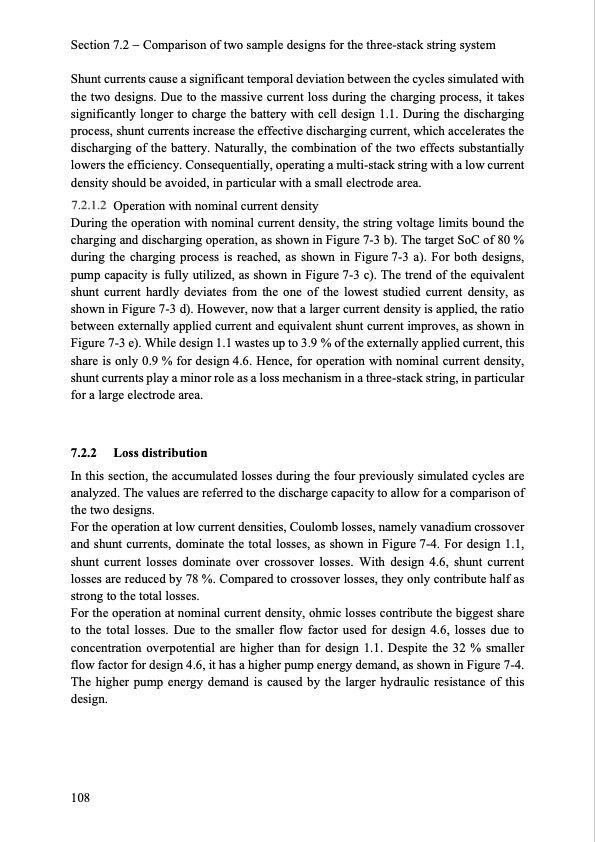
PDF Publication Title:
Text from PDF Page: 116
Section 7.2 Comparison of two sample designs for the three-stack string system Shunt currents cause a significant temporal deviation between the cycles simulated with the two designs. Due to the massive current loss during the charging process, it takes significantly longer to charge the battery with cell design 1.1. During the discharging process, shunt currents increase the effective discharging current, which accelerates the discharging of the battery. Naturally, the combination of the two effects substantially lowers the efficiency. Consequentially, operating a multi-stack string with a low current density should be avoided, in particular with a small electrode area. Operation with nominal current density During the operation with nominal current density, the string voltage limits bound the charging and discharging operation, as shown in Figure 7-3 b). The target SoC of 80 % during the charging process is reached, as shown in Figure 7-3 a). For both designs, pump capacity is fully utilized, as shown in Figure 7-3 c). The trend of the equivalent shunt current hardly deviates from the one of the lowest studied current density, as shown in Figure 7-3 d). However, now that a larger current density is applied, the ratio between externally applied current and equivalent shunt current improves, as shown in Figure 7-3 e). While design 1.1 wastes up to 3.9 % of the externally applied current, this share is only 0.9 % for design 4.6. Hence, for operation with nominal current density, shunt currents play a minor role as a loss mechanism in a three-stack string, in particular for a large electrode area. 7.2.2 Loss distribution In this section, the accumulated losses during the four previously simulated cycles are analyzed. The values are referred to the discharge capacity to allow for a comparison of the two designs. For the operation at low current densities, Coulomb losses, namely vanadium crossover and shunt currents, dominate the total losses, as shown in Figure 7-4. For design 1.1, shunt current losses dominate over crossover losses. With design 4.6, shunt current losses are reduced by 78 %. Compared to crossover losses, they only contribute half as strong to the total losses. For the operation at nominal current density, ohmic losses contribute the biggest share to the total losses. Due to the smaller flow factor used for design 4.6, losses due to concentration overpotential are higher than for design 1.1. Despite the 32 % smaller flow factor for design 4.6, it has a higher pump energy demand, as shown in Figure 7-4. The higher pump energy demand is caused by the larger hydraulic resistance of this design. 108PDF Image | Model-based Design Vanadium Redox Flow Batteries

PDF Search Title:
Model-based Design Vanadium Redox Flow BatteriesOriginal File Name Searched:
10-5445IR1000070670.pdfDIY PDF Search: Google It | Yahoo | Bing
Salgenx Redox Flow Battery Technology: Salt water flow battery technology with low cost and great energy density that can be used for power storage and thermal storage. Let us de-risk your production using our license. Our aqueous flow battery is less cost than Tesla Megapack and available faster. Redox flow battery. No membrane needed like with Vanadium, or Bromine. Salgenx flow battery
| CONTACT TEL: 608-238-6001 Email: greg@salgenx.com | RSS | AMP |